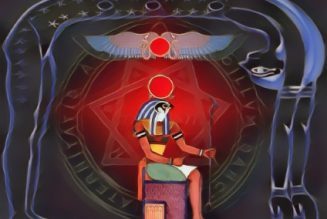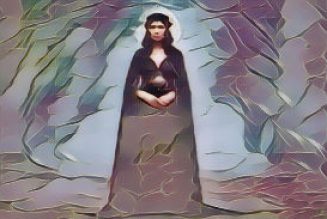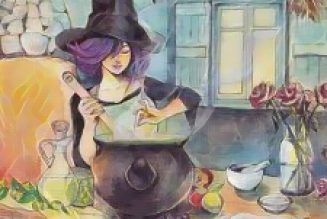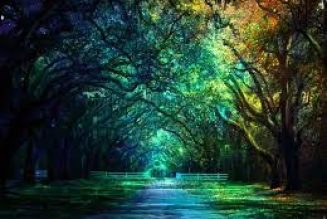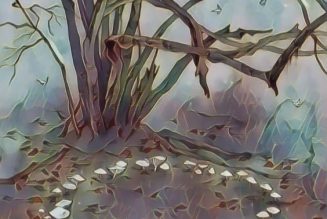The magical name of Violet Mary Firth, British occultist and author whose books continue to have an impact on modern witchcraft and Paganism.
Considered one of the leading occultists of her time, Dion Fortune was an adept in ceremonial magic and was perhaps one of the first occult writers to approach magic and hermetic concepts from the psychology of Jung and Freud .
Some contemporary Witches and Pagans consider her fiction more important than her non fiction, for her novels contain Pagan themes and are a rich source for rituals.
Fortune was born into a family of Christian Scientists and displayed mediumistic abilities in her teen years.
In her early twenties, she worked as a law analyst at the Medico-Psychological Clinic in London.
Her interest in exploring the human psyche resulted from an unpleasant episode in 1911, when, at age 29, she went to work in a school for a principal who took a great personal dislike to her.
When Fortune went to see the woman to announce she was leaving her job, she was subjected to invective that she had no self-confidence and was incompetent.
Fortune said later that the principal also conveyed this by psychic attack, using yogic techniques and hypnotism that left Fortune a “mental and physical wreck” for three years.
As a result, she studied psychology, delving into the works of both Freud and Jung.
She preferred the ideas of Jung but eventually concluded that neither Freud nor Jung adequately addressed the subtleties and complexities of the mind.
The answers, Fortune felt, lay in occultist. In 1919 Fortune joined the Alpha and Omega Lodge of the Stella Matutina, an outer order of the Hermetic Order of the Golden Dawn, and studied under J. W. Brodie-Innes.
She experienced clashes with the wife of S. L. MacGregor-Mathers, one of the founders of the Golden Dawn, which she again felt were forms of psychic attack.
She left Stella Matutina in 1924 and founded her own order, the Community (later Fraternity) of the Inner Light. The order initially was part of the Golden Dawn but later separated from it.
Fortune worked as a psychiatrist, which brought her into contact with other cases of psychic attack.
She was a prolific writer, pouring her occult knowledge into both novels and nonfiction.
Her pen name was derived from the magical motto she adopted upon joining the Stella Matutina, “Deo Non Fortuna,” (“by God, not chance”), which became shortened to Dion Fortune.
Her books are considered classics and continue to enjoy wide readership.
For a time she lived in Glastonbury and became deeply interested in the Arthurian legends and magical-mystical lore centered there.
She wrote about Glastonbury in Avalon of the Heart.
Fortune used her experiences with psychic attack to conclude that hostile psychic energy can emanate both deliberately and unwittingly from certain people and that one can mentally fend off such energy.
Her book PsychicSelf-Defense (1930) remains the best guide to detection and defence against psychic attack.
One of her most famous books is The Mystical Qabbalah (1936), in which she discusses the Western esoteric tradition and how the Qabbalah is used by modern students of the Mysteries.
The true nature of the gods, she said, is that of magical images shaped out of the astral plane by mankind’s thought, and is influenced by the mind.
Her other major nonfiction works include Sane Occultism (1929);
The Training and Work of an Initiate (1930);
Through the Gates of Death (1932);
Applied Magic; Aspects of Occultism; and Spiritualism in the Light of Occult Science. Machinery of the Mind (1922) was published under her given name.
But it is her novels that have captured the most interest among modern Witches and Pagans. In particular, The Goat-Foot God (1936) concerns the powers of Pan, a Horned God, and offers a wealth of details on leys;
The Sea-Priestess (1938) concerns the power of Isis, the moon goddess, and has been used by modern witches as an inspiration for creating rituals and invocations.
Her other novels are The Secrets of Dr. Taverner (1926), aboutan adept who runs an occult nursing home;
The Demon Lover (1927); and The Winged Bull (1936). Fortune was married to Dr. Thomas Penry Evans.
She died in January 1946.
The Fraternity of the Inner Light remains based in London and now is known as the Society of the Inner Light.
It offers techniques in the Western esoteric tradition.
The Society stresses that Fortune was not a Witch and was not involved with any coven and that the Society is not connected with Witchcraft in any way























![Covensense by Crowther, Patricia [Paperback]](https://i.ebayimg.com/images/g/k8MAAeSwzcZofgmE/s-l225.jpg)


















